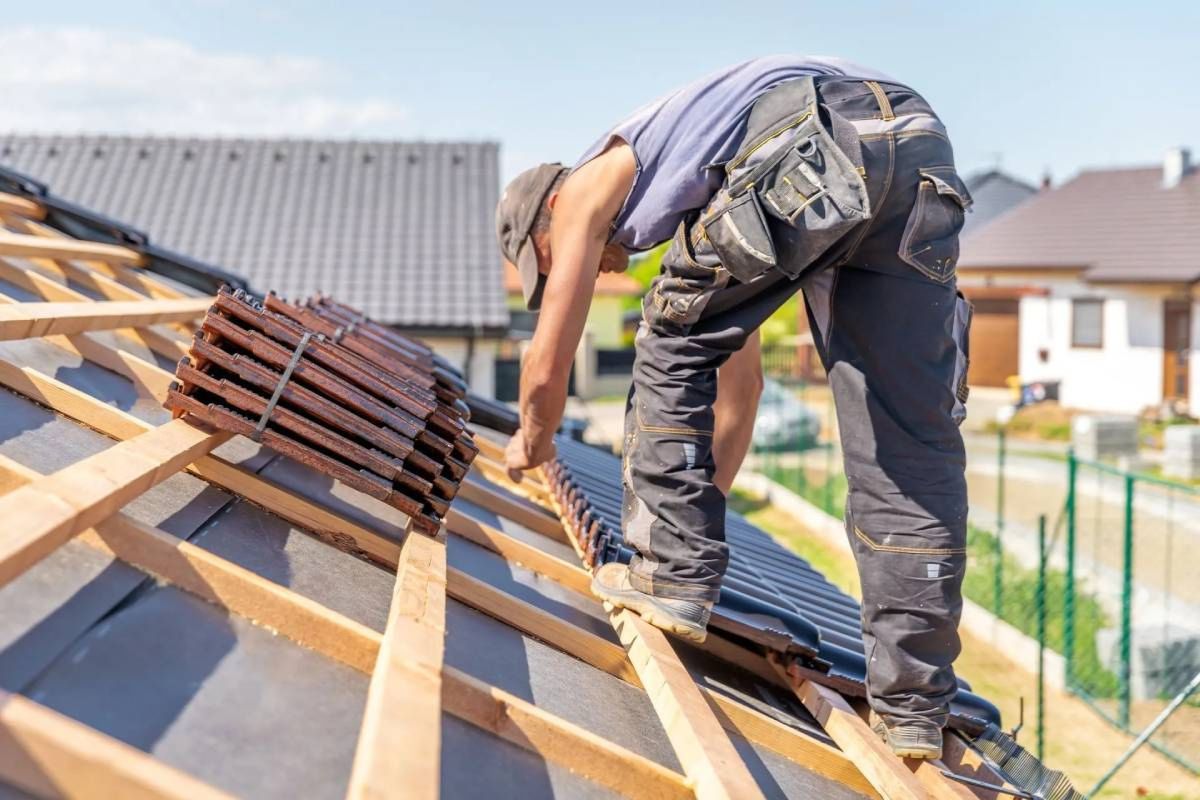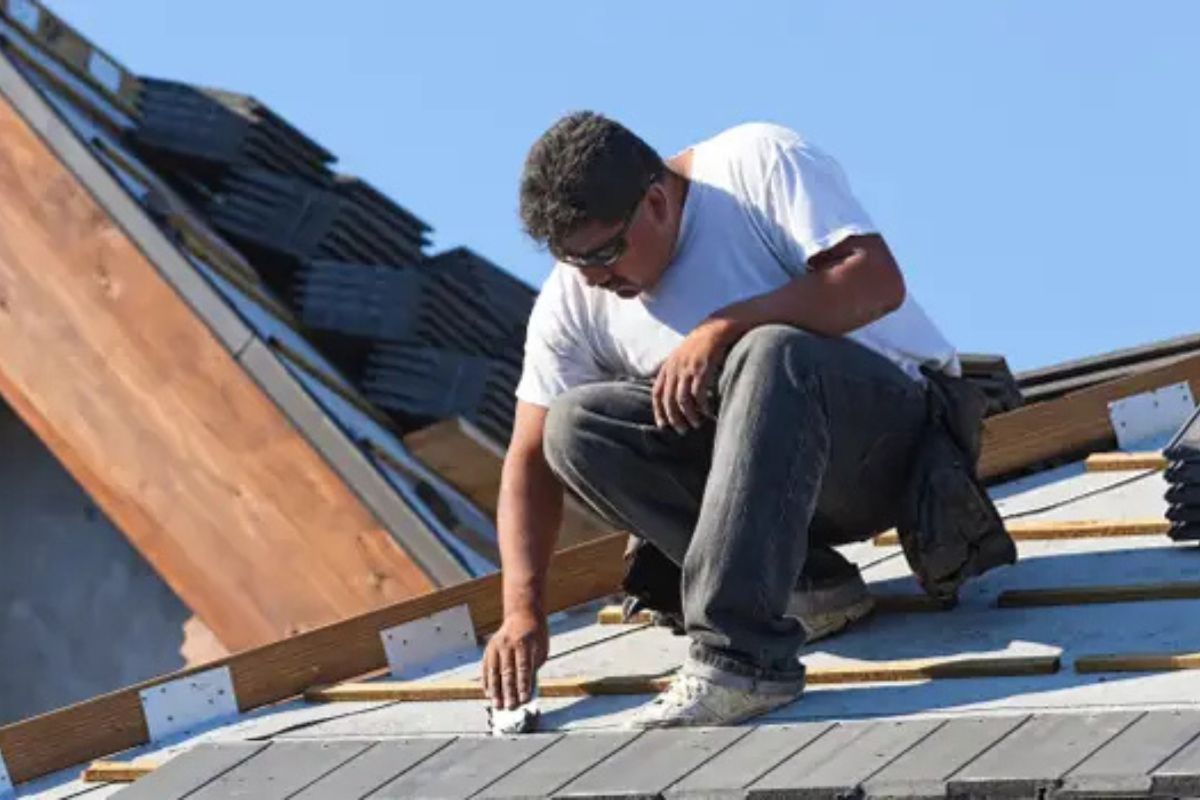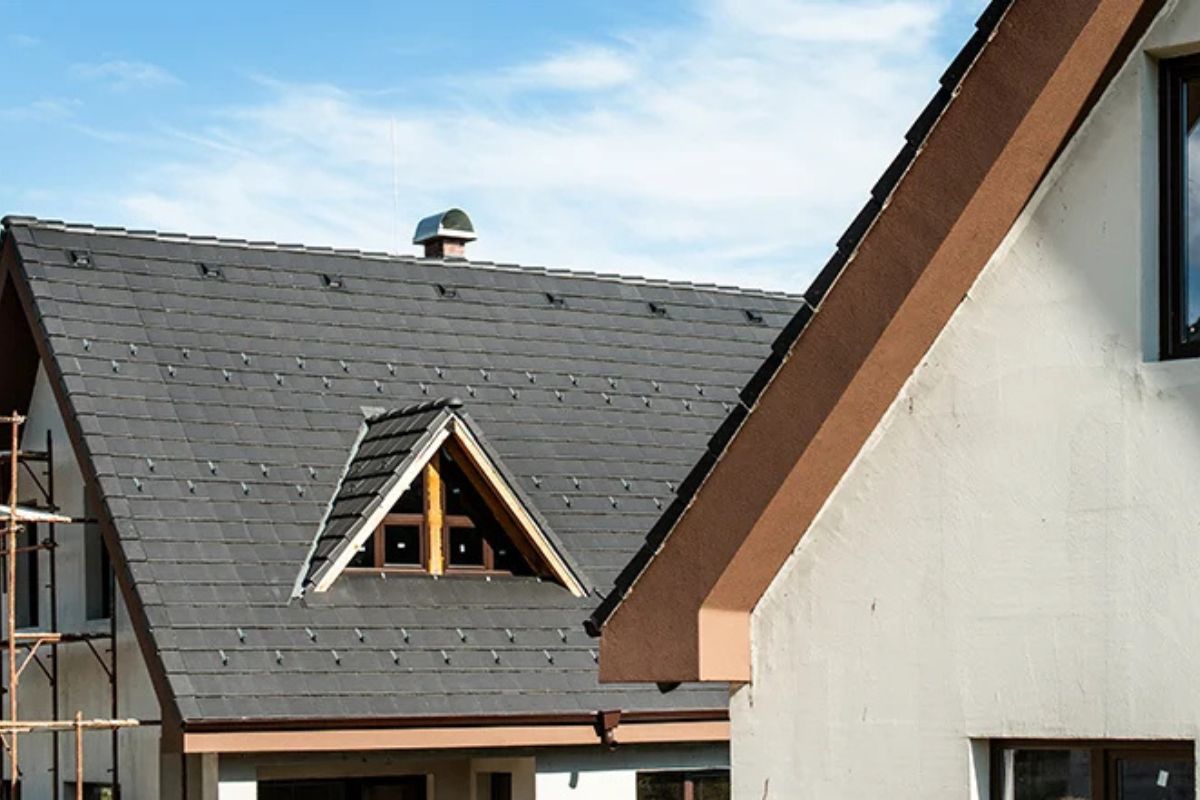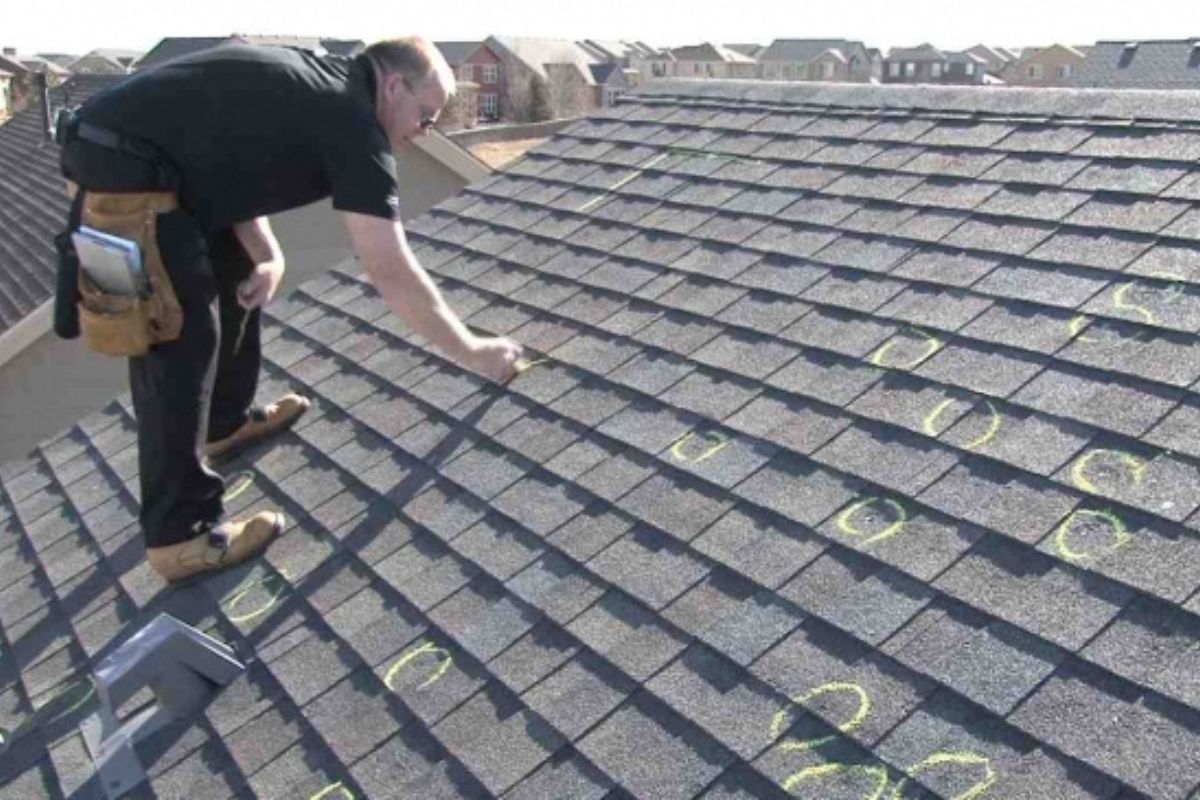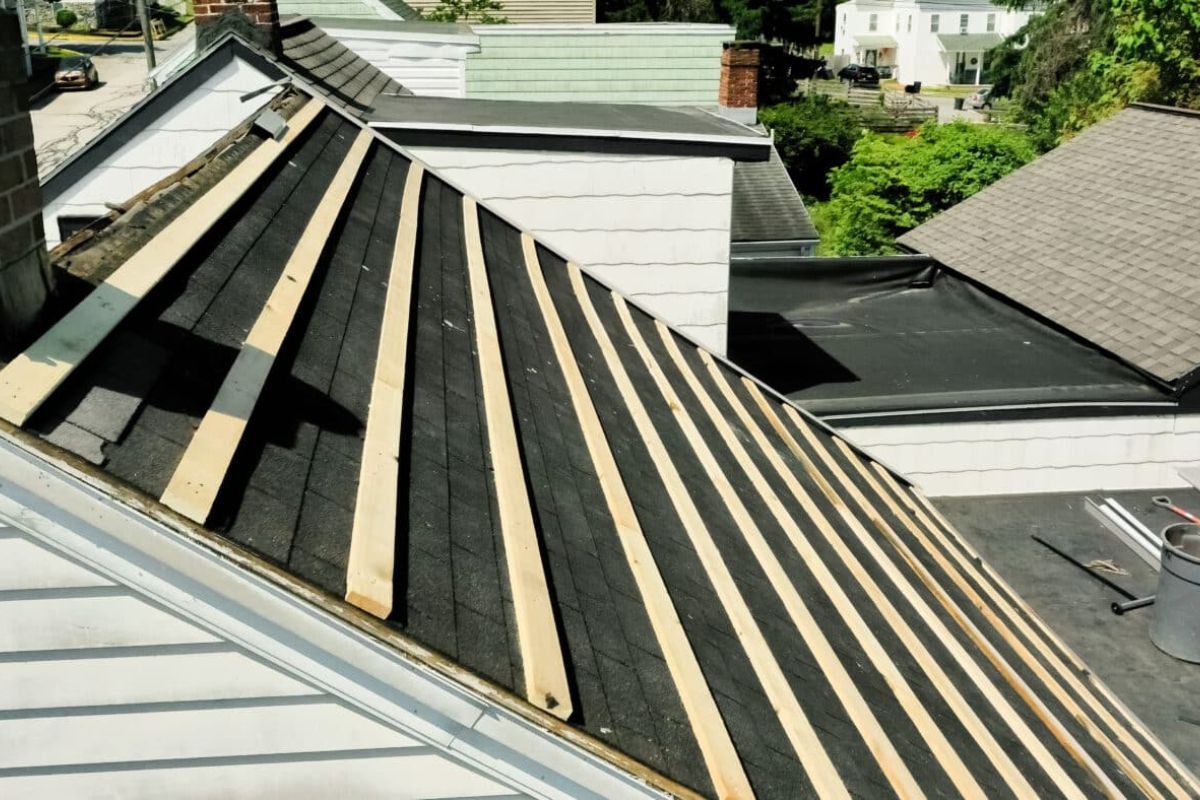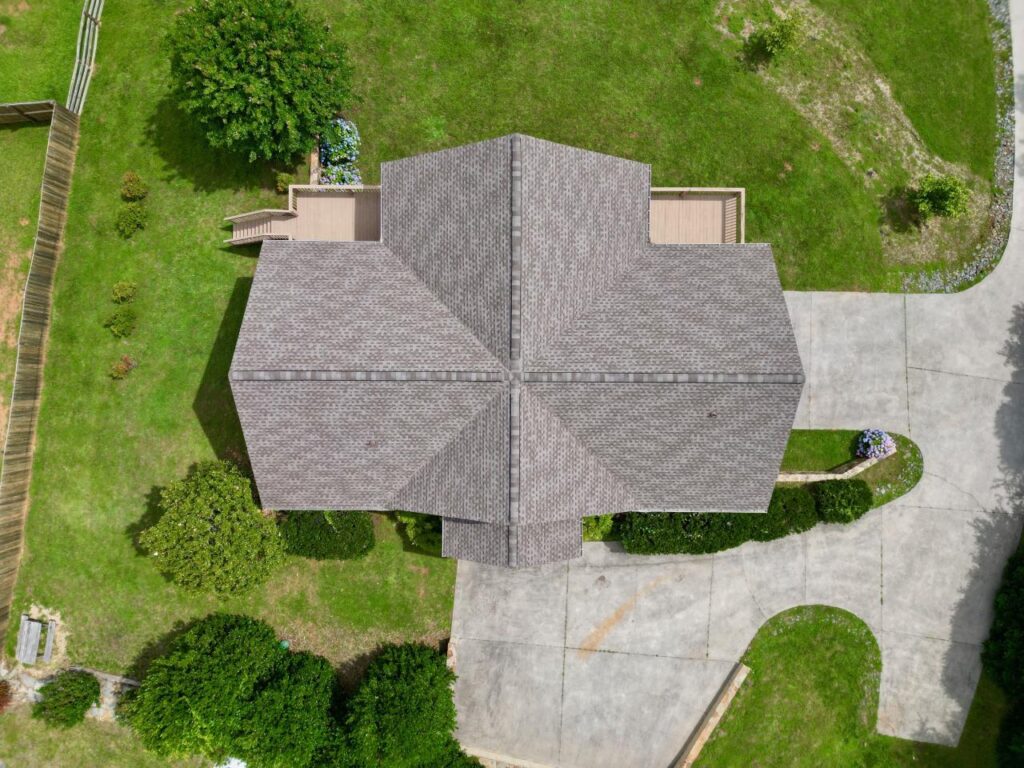The Least Expensive Way to Roof a House is three-tab asphalt shingles which cost $1-2 per square foot and represent the cheapest roofing material available. Combined with simple gable roof designs and winter installation timing, homeowners can achieve total project costs of $3,400-$4,600 for a typical 1,500 square foot roof.
Roof replacement ranks among the most expensive home improvements, with average costs ranging from $5,700 to $12,000. Smart material selection, strategic timing, and proper planning can reduce these expenses significantly while maintaining quality protection.
What Are the Cheapest Roofing Materials Available?
Three-tab asphalt shingles provide the lowest-cost roofing solution at $1-2 per square foot for materials. These basic shingles offer 15-25 years of protection and work with most roof designs.
Three-Tab Asphalt Shingles
Three-tab asphwhen shingles dominate the budget roofing market. Material costs range from $80-200 per square (100 square feet). Installation adds $200-400 per square, bringing total costs to $280-600 per square installed.
Key specifications include 60 mph wind resistance, Class A fire rating, 200-250 pounds per square weight, and 15-25 year warranties.
Rolled Roofing
Rolled roofing costs $0.50-1.50 per square foot and works best for flat or low-slope applications. This material comes in 36-inch wide rolls covering 100 square feet each.
Applications include flat residential roofs, shed and garage roofs, temporary roof repairs, and mobile home installations.
Architectural Shingles
Architectural shingles cost 15% more than three-tab versions but provide superior durability. Material costs range from $100-350 per square, with installation adding $250-450 per square.
Benefits include 25-30 year lifespan, 110-130 mph wind resistance, enhanced curb appeal, and better warranty coverage.
Which Roof Designs Cost the Least to Build?
Gable roofs cost 20-30% less than complex designs due to simple construction and fewer materials. Single-slope shed roofs offer even greater savings for appropriate applications.
Gable Roof Construction
Gable roofs feature two sloping sides meeting at a central ridge. Construction requires fewer materials and less skilled labor compared to complex designs.
Cost advantages include simplified framing, reduced material waste, faster installation, and lower labor hours.
Shed Roof Benefits
Shed roofs slope in one direction and cost 15-25% less than gable designs. Modern homes and additions frequently use shed roofs for their simplicity.
Applications include contemporary home designs, garage and workshop construction, home additions, and covered porches.
Expensive Roof Designs to Avoid
Complex roof shapes increase material and labor costs significantly. Hip roofs, mansard roofs, and multi-level designs can double installation expenses.
Costly features include multiple roof planes, dormers and skylights, complex valley systems, and steep pitch requirements.
When Is the Cheapest Time to Replace a Roof?
Winter represents the least expensive season for roof replacement, with contractors offering 10-20% discounts due to reduced demand. Late fall provides the best balance of savings and favorable weather conditions.
Winter Installation Advantages
Roofing contractors experience slower business during winter months. Reduced demand allows homeowners to negotiate better pricing and faster scheduling.
Winter benefits include lower contractor rates, immediate availability, flexible scheduling, and reduced permit wait times.
Late Fall Timing
Late fall offers moderate weather conditions and contractor availability. October through November provides optimal installation conditions in most regions.
Weather advantages include stable temperatures, reduced precipitation, longer daylight hours, and proper material adhesion.
Peak Season Costs
Spring and summer represent peak roofing seasons with highest demand and pricing. Contractors charge premium rates during these busy periods.
Peak season challenges include higher material costs, extended wait times, limited contractor availability, and weather-related delays.
How Can Labor Costs Be Reduced?
Labor comprises 60% of total roofing costs, making contractor selection and negotiation critical for budget management. Multiple quotes, local contractors, and roof overlays can reduce labor expenses significantly.
Obtaining Multiple Quotes
Contractor estimates vary by 20-40% for identical projects. Three quotes minimum allows comparison of pricing, materials, and warranties.
Quote comparison factors include material specifications, labor rates, project timeline, and warranty coverage.
Local Contractor Benefits
Local roofing contractors often provide lower rates than national companies. Regional contractors have reduced overhead costs and competitive pricing strategies.
Local advantages include lower operational costs, established supplier relationships, reduced travel expenses, and community reputation focus.
Roof Overlay Options
Roof overlays install new shingles over existing materials, reducing labor costs by 30-50%. This method works when existing roofs show minimal damage.
Overlay requirements include single existing layer, structurally sound decking, proper ventilation, and code compliance.
What About DIY Roof Installation?
DIY installation can reduce total costs by 60% but requires significant construction experience and proper safety equipment. Professional installation remains recommended for most homeowners due to safety and warranty concerns.
DIY Cost Savings
Material-only costs range from $1,500-3,000 for typical residential roofs. Professional installation adds $3,000-6,000 in labor expenses.
DIY requirements include construction experience, safety equipment, proper tools, and building permits.
Professional Installation Benefits
Licensed contractors provide warranty coverage, proper installation techniques, and safety compliance. Most shingle manufacturers require professional installation for warranty validity.
Professional advantages include warranty protection, safety compliance, proper techniques, and code adherence.
What Financing Options Reduce Upfront Costs?
Home equity loans provide the lowest interest rates for roof financing, ranging from 5-10% annually. Personal loans and government programs offer additional funding alternatives.
Home Equity Financing
Home equity loans and lines of credit use home value as collateral. These products offer favorable rates and potential tax benefits.
Equity financing features include low interest rates, tax deductible interest, long repayment terms, and large borrowing amounts.
Personal Loan Options
Personal loans provide unsecured financing for roof projects. Rates range from 6-36% based on credit scores and loan amounts.
Personal loan benefits include fast approval process, no collateral required, fixed payment amounts, and flexible terms.
Government Assistance Programs
Federal and state programs assist qualified homeowners with roofing costs. FHA 203k loans and weatherization programs provide funding options.
Government programs include FHA renovation loans, USDA rural development grants, weatherization assistance, and VA loan programs.
How Does Metal Roofing Compare for Budget Buyers?
Metal roofing costs $7-12 per square foot installed but provides 40-70 year lifespans. Corrugated steel represents the most affordable metal option at $5-8 per square foot.
Metal Roofing Costs
Initial metal roofing costs exceed asphalt shingles by 2-3 times. Long-term value calculations favor metal for homeowners planning extended residence.
Metal pricing includes:
- Corrugated steel: $5-8 per square foot
- Standing seam: $9-16 per square foot
- Metal shingles: $7-12 per square foot
- Copper roofing: $15-25 per square foot
Long-Term Value Analysis
Metal roofs last 40-70 years compared to 15-25 years for asphalt shingles. Energy savings and insurance discounts offset higher initial costs over time.
Value factors include extended lifespan, energy efficiency, insurance discounts, and minimal maintenance.
What Maintenance Extends Roof Life?
Regular inspections and prompt repairs can extend roof life by 30-50%. Biannual inspections, gutter cleaning, and immediate leak repairs prevent costly damage.
Inspection Schedule
Professional inspections every 3-5 years identify problems before major damage occurs. Homeowner inspections twice yearly monitor roof condition.
Inspection checklist includes missing or damaged shingles, gutter condition, flashing integrity, and ventilation function.
Preventive Maintenance
Small repairs prevent major problems and extend roof life significantly. Immediate attention to missing shingles, loose flashing, and gutter issues saves money.
Maintenance tasks include shingle replacement, gutter cleaning, debris removal, and flashing repair.
How Do Regional Factors Affect Costs?
Regional building codes, climate conditions, and labor rates create 20-40% cost variations between markets. Hurricane zones, earthquake regions, and extreme weather areas require specialized materials and installation methods.
Climate Considerations
Local weather patterns determine appropriate roofing materials and installation requirements. Hot climates need UV-resistant materials, while cold regions require ice dam protection.
Climate factors include temperature extremes, precipitation levels, wind speeds, and UV exposure.
Building Code Requirements
Local building codes specify minimum standards for roofing materials and installation methods. Hurricane zones require higher wind ratings, while fire-prone areas mandate specific materials.
Code requirements include wind resistance ratings, fire safety standards, installation methods, and permit requirements.
Labor Rate Variations
Regional labor costs vary significantly based on local economic conditions. High-cost metropolitan areas charge $4-6 per square foot, while rural regions average $2-3 per square foot.
Labor factors include regional wage standards, contractor availability, material transportation, and permit costs.
What Are Common Cost-Saving Mistakes to Avoid?
Extremely low contractor bids often indicate substandard materials or installation shortcuts. Quotes 30% below market rates typically involve hidden costs or quality compromises.
Low-Bid Red Flags
Unusually low contractor bids may indicate unlicensed workers, inferior materials, or hidden charges. Quality roofing requires proper materials and skilled installation.
Warning signs include significantly low pricing, door-to-door solicitation, large upfront payments, and no written contracts.
Material Quality Issues
Cheap materials may fail prematurely and void warranties. Manufacturer specifications and professional recommendations guide proper material selection.
Quality indicators include manufacturer warranties, professional recommendations, building code compliance, and installation requirements.
How Can Homeowners Maximize Their Investment?
Proper contractor selection, quality materials, and regular maintenance maximize roof value and lifespan. Professional installation and comprehensive warranties protect long-term investment.
Contractor Selection Criteria
Licensed, insured contractors with local references provide the best value. Better Business Bureau ratings and customer reviews indicate reliability.
Selection factors include licensing and insurance, local references, BBB ratings, and written warranties.
Material Specifications
Manufacturer specifications determine material performance and warranty coverage. Professional consultation helps select appropriate materials for local conditions.
Specification factors include climate suitability, building code compliance, warranty terms, and installation requirements.
Project Timeline Management
Proper scheduling prevents weather delays and cost overruns. Experienced contractors provide realistic timelines and contingency planning.
Timeline considerations include weather conditions, material availability, permit processing, and contractor scheduling.
What Should Homeowners Expect During Installation?
Professional roof installation typically takes 1-3 days for residential projects. Weather conditions, roof complexity, and material selection affect project duration.
Installation Process
Roof installation follows standardized procedures for safety and quality. Professional contractors coordinate material delivery, weather monitoring, and cleanup services.
Installation steps include material delivery, old roof removal, decking inspection, and new material installation.
Quality Control Measures
Professional contractors perform quality inspections at each installation phase. Final inspections verify proper installation and warranty compliance.
Quality checkpoints include decking condition, underlayment installation, shingle alignment, and flashing integrity.
What Long-Term Considerations Matter Most?
Total cost of ownership includes initial installation, maintenance, and replacement costs over the roof’s lifespan. Energy efficiency, insurance discounts, and home value impact long-term financial benefits.
Total Cost Analysis
Roof selection should consider lifetime costs rather than initial price alone. Quality materials and professional installation reduce long-term expenses.
Cost factors include initial installation, maintenance requirements, energy efficiency, and replacement timeline.
Home Value Impact
New roofs typically recover 60-70% of installation costs in home value. Quality materials and professional installation maximize value addition.
Value considerations include material quality, installation craftsmanship, warranty coverage, and energy efficiency.
Final Thoughts
The least expensive roofing approach combines three-tab asphalt shingles, simple gable designs, and winter installation timing. This strategy achieves quality protection at minimum cost while maintaining safety standards and warranty coverage.
Budget-conscious homeowners can achieve significant savings through careful material selection, strategic timing, and proper contractor selection. Professional installation remains essential for warranty coverage and long-term performance.
Georgia homeowners benefit from experienced local contractors who understand regional requirements and provide competitive pricing. Quality roofing protection doesn’t require premium pricing when proper planning and execution guide the project.
Smart roofing decisions balance initial costs with long-term value, creating lasting protection that fits family budgets. Professional guidance helps navigate material options and installation requirements for optimal results.


